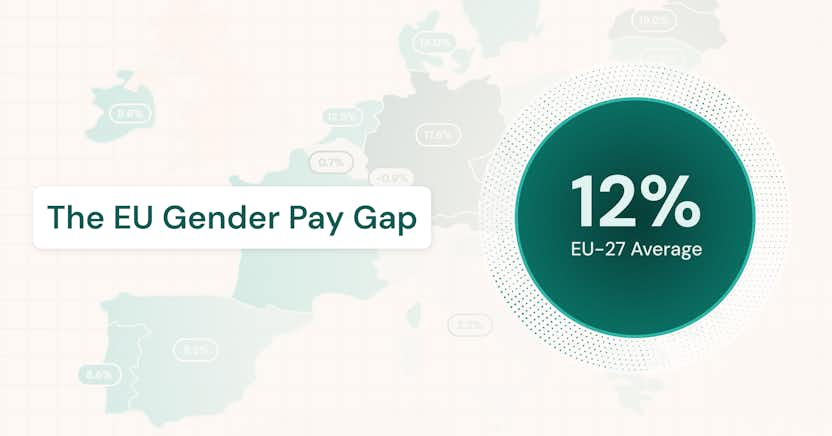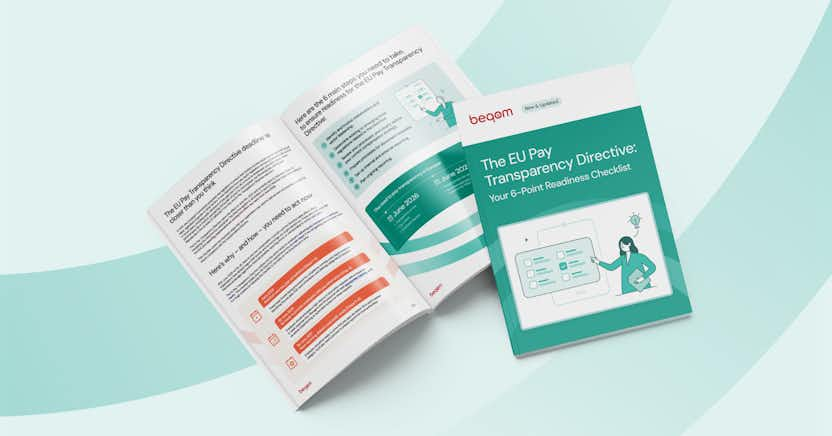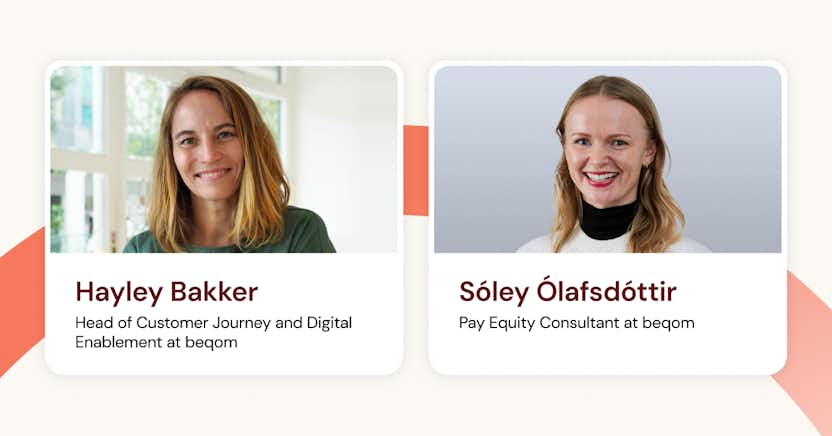Employee Turnover: The Definitive Guide to Understanding, Measuring, and Reducing It

Learn more about the following beqom products
Employee turnover is one of the most critical metrics for HR professionals, compensation leaders, and business executives. A high employee turnover rate can disrupt operations, increase hiring costs, and lower employee engagement. On the other hand, effectively managing turnover rates can lead to a more engaged workforce, reduced recruitment expenses, and a stronger company culture.
But how do you determine if your employee turnover rate is a problem? How do you calculate it accurately? What strategies can help you reduce employee turnover and improve employee retention?
In this guide, we’ll explore everything you need to know about employee turnover, including its causes, how to measure it, and the best practices for reducing it.
What is employee turnover?
Employee turnover refers to the percentage of employees who leave an organization within a specific time period, typically measured annually. While some level of turnover is expected, excessive turnover can indicate deeper organizational problems that need attention.
Types of employee turnover
Not all employee turnover is the same. Understanding the different types can help businesses take the right actions.
Voluntary turnover
This occurs when an employee leaves the company by choice. Common reasons include:
- Seeking better career opportunities
- Dissatisfaction with salary or benefits
- Poor work-life balance
- Lack of employee engagement
- Unclear career progression opportunities
Involuntary turnover
This happens when the employer initiates the separation due to:
- Performance issues
- Misconduct
- Layoffs or downsizing
Is turnover always bad?
Not necessarily. Some turnover is healthy, especially if it allows an organization to replace low performers with high achievers. However, a consistently high turnover rate—especially involving top talent—can signal serious HR and compensation issues that must be addressed.
How to calculate employee turnover rate
Measuring employee turnover correctly is essential for making data-driven HR decisions. Here’s how you do it.
Step 1: Gather employee data
To calculate your turnover rate, you need:
- The total number of employees at the start of the time period
- The total number of employees at the end of the time period
- The number of employees who left during the time period
Step 2: Use the turnover rate formula
The standard employee turnover rate formula is:
Turnover Rate = (Number of Employees Who Left / Average Number of Employees) × 100
Example calculation
- Employees at the start of the year: 500
- Employees at the end of the year: 550
- Employees who left during the year: 75
- Average number of employees: (500 + 550) ÷ 2 = 525
- Turnover rate: (75 ÷ 525) × 100 = 14.3%
What is considered a high employee turnover rate?
In our previous example, would a 14.3% turnover rate be good or bad? As a rule of thumb, a turnover rate below 10% is considered good, but in fact 14.3% may or may not be high—it depends on industry benchmarks and internal retention goals.
A high turnover rate varies by industry. For example, industries with seasonal work or high demand for talent naturally experience more employee turnover than others.
Industry-specific turnover benchmarks | |
|---|---|
Industry | Average turnover rate |
Retail & Hospitality | 60-80% |
Manufacturing | 20-30% |
Healthcare | 15-30% |
Technology | 13-20% |
Finance & Insurance | 10-15% |
How to compare your turnover rate to industry standards
To determine whether your employee turnover rate is too high:
✔ Compare your data with Bureau of Labor Statistics (BLS) benchmarks.
✔ Conduct employee engagement surveys to understand workplace issues.
✔ Perform exit interviews to identify turnover trends.
If your turnover rate is significantly above your industry’s average, it's time to take action.
The cost of high employee turnover
High employee turnover isn't just an HR issue—it’s also a financial one, due to:
1. Increased hiring and training costs
Replacing an employee costs between 50% to 200% of their annual salary, including:
- Job advertising expenses
- Recruitment fees
- Training costs for new hires
2. Loss of productivity
It takes 6 months to 1 year for a new employee to reach full productivity.
3. Decline in employee morale
High turnover rates can create instability, stress, and decreased employee engagement.
Reducing employee turnover is about protecting your bottom line.
How to reduce employee turnover
Reducing employee turnover requires strategic, data-driven HR practices.
1. Offer competitive compensation and benefits
Compensation is one of the top reasons employees leave. To reduce employee turnover, companies should:
- Benchmark salaries against competitors using compensation management software.
- Provide performance-based bonuses.
- Offer comprehensive benefits, including healthcare, retirement plans, and work-life balance initiatives.
Learn More About Compensation Management Software
2. Improve career development opportunities
Employees are more likely to stay when they see career growth within the company. Companies can:
- Offer mentorship programs.
- Provide training and development initiatives.
- Implement internal promotion opportunities.
3. Foster a positive company culture
Employees are less likely to leave when the company culture makes them feel valued. A few things you can do include:
- Promote transparent leadership
- Recognize and reward employee contributions
- Support diversity and inclusion efforts
4. Use AI-Driven Compensation Strategies
AI-powered compensation management helps:
- Ensure fair and competitive salaries.
- Predict turnover trends based on compensation patterns.
- Increase pay transparency to build trust.
This is why companies need a solid employee retention strategy.
The relationship between employee turnover rate, retention, and tenure
Understanding the connection
Employee turnover rate, retention rate, and average tenure are three key HR metrics that provide insight into workforce stability and employee engagement. While they are closely related, they measure different aspects of employment:
- Turnover Rate measures the percentage of employees leaving an organization within a specific period.
- Retention Rate measures the percentage of employees who stay with the organization over that same period.
- Average Tenure refers to the length of time employees remain with a company before leaving.
How they interact
These metrics are interconnected in the following ways:
✔ A low turnover rate generally correlates with a higher retention rate, as more employees are staying with the company.
✔ A lower turnover rate tends to result in a longer average tenure, since employees are leaving less frequently.
✔ A company with a high retention rate will typically see longer employee tenures, as fewer employees exit over time.
However, a low turnover rate does not automatically mean employees have significantly longer tenures. This depends on factors such as hiring growth, workforce composition, and internal mobility opportunities.
Breaking down the metrics
1. Employee turnover rate versus retention rate
Turnover and retention rates are two sides of the same coin:
Retention Rate=100%−Turnover Rate
For example:
- If a company has a turnover rate of 15%, its retention rate is 85%.
- If a company has a turnover rate of 30%, its retention rate is 70%.
Thus, a higher retention rate means fewer employees are leaving, which often translates to longer tenure—but not always.
2. Employee turnover rate versus average tenure
Does a low turnover rate mean employees stay longer? In many cases, yes—but not always.
Scenario 1: Low Turnover, Increasing Tenure
If turnover is low and hiring remains stable, employees tend to stay longer, leading to higher average tenure.
Example: A 10% turnover rate in a company that has been stable for years will lead to employees having longer tenures.
Scenario 2: Low Turnover, Short Tenure
If a company has a low turnover rate but has rapidly expanded, it may still have a short average tenure because many employees are new hires.
Example: A startup that doubles its workforce in two years may have a low turnover rate, but its average tenure may still be short because most employees are recent hires.
Scenario 3: High Turnover, Short Tenure
If turnover is high, average tenure will naturally be lower because employees leave more frequently.
Example: In industries like retail and hospitality, where turnover rates exceed 60%, the average tenure is often less than two years.
Scenario 4: High Turnover, Long Tenure
In rare cases, a company may have a high turnover rate but still retain a core group of long-tenured employees.
Example: A company with seasonal hiring cycles (like retail chains) may see frequent exits of short-term workers, while a core of long-term employees remain.
How turnover rates impact workforce stability
✅ A low turnover rate generally results in:
- Higher institutional knowledge – Employees stay longer, developing skills and expertise.
- Lower recruitment and training costs – Less frequent hiring reduces expenses.
- Stronger company culture – Long-term employees foster a stable, cohesive work environment.
❌ A high turnover rate typically leads to:
- Lower average tenure – Employees leave more frequently.
- Higher hiring and onboarding costs – Continuous recruitment increases HR expenses.
- Reduced team cohesion – Frequent staff changes disrupt team dynamics.
Industry comparisons: turnover rate versus average tenure
The following table shows the relationship between turnover rate and tenure across some key industries.
Industry comparisons: turnover rate versus average tenure | ||
|---|---|---|
Industry | Average turnover rate | Average employee tenure |
Retail & Hospitality | 60-80% | ~1.8 years |
Manufacturing | 20-30% | ~4.5 years |
Healthcare | 15-30% | ~4.2 years |
Technology | 13-20% | ~3.2 years |
Finance & Insurance | 10-15% | ~5.3 years |
Key Insights:
- Industries with higher turnover (like retail and hospitality) tend to have shorter average tenure.
- Industries with lower turnover (like finance and insurance) see longer average tenure.
- However, it is not a direct correlation.
What turnover and tenure mean for companies
- A low turnover rate generally leads to longer employee tenure, but hiring patterns and industry factors also play a role.
- Retention strategies should focus on more than simply lowering turnover—they should enhance engagement and career growth to encourage employees to stay long-term.
- Monitoring both turnover rate and average tenure gives a clearer picture of workforce stability than looking at either metric alone.
Case studies: How leading companies maintain low employee turnover
Successful organizations prioritize employee retention by focusing on compensation, career development, company culture, and innovative HR strategies. The following case studies highlight how Google, Costco, and Salesforce maintain low employee turnover rates through industry-leading practices.
1. Adobe: Continuous learning & internal mobility to drive retention
How Adobe retains talent
Adobe is recognized as one of the best places to work, largely due to its strong investment in employee development and internal mobility programs. In an industry with an average turnover rate of 13-20%, Adobe’s is thought to hover closer to 8-10%. The company fosters continuous learning, leadership training, and job flexibility, ensuring employees feel valued and have long-term career opportunities within Adobe.
Key initiatives include:
- Check-in Performance Management Model – Adobe eliminated annual performance reviews and replaced them with continuous feedback and growth discussions, helping employees align personal and company goals.
- Internal Career Mobility & Rotational Programs – Employees are encouraged to explore different roles within the company, allowing them to develop new skills without leaving Adobe.
The impact on retention
- Employees engaged in career development programs are significantly less likely to leave.
- Adobe’s turnover rate remains around 8-10%, lower than the tech industry average (13-20%).
- Adobe's culture of growth and feedback results in higher employee satisfaction and longer tenure.
Providing structured learning opportunities and career mobility keeps employees engaged and reduces turnover.
2. Costco: Paying above market wages to reduce turnover in retail
How Costco retains talent
The retail industry typically faces super high turnover rates, in the range of 60-80% due to low wages and limited benefits. Costco stands out by offering above-market compensation and benefits, leading to significantly higher employee retention than competitors – reportedly closer to 8%.
Costco key strategies include:
- Above-Industry Wages – Costco pays an average hourly wage around $20, exceeding competitors like Walmart and Target.
- Comprehensive Benefits – Unlike many retailers, Costco offers healthcare, paid time off, and retirement benefits to both full-time and part-time employees.
- Stock Ownership and Profit Sharing – Employees receive Costco stock options, giving them a stake in the company's long-term success.
The impact on retention
- Costco’s turnover rate is significantly lower than the retail industry average, resulting in lower costs for recruiting and training.
- Employees with 5+ years of tenure have a retention rate of 94%.
- High employee satisfaction leads to better customer service and increased sales.
Competitive wages and favorable benefits create a loyal workforce, even in high-turnover industries.
3. Toyota: A manufacturing giant with low turnover and high retention
How Toyota retains employees
Toyota is one of the most stable employers in the automotive and manufacturing sector, maintaining a turnover rate of ~5-6%—far lower than the manufacturing industry average of 20-30%. The company achieves this through competitive pay, job security, a strong culture of continuous improvement (Kaizen), and extensive employee development programs.
Key retention strategies
Long-Term Job Security & Stability
- Unlike many manufacturers that rely heavily on temporary contracts, Toyota focuses on permanent employment, creating a culture of stability and loyalty.
- Toyota is known for avoiding mass layoffs, even during economic downturns, strengthening employee trust.
Competitive Wages & Benefits
- Toyota offers above-average wages for manufacturing roles, along with profit-sharing programs.
- Employees receive strong healthcare benefits, retirement plans, and bonuses based on company performance.
Kaizen (Continuous Improvement) & Employee Empowerment
- The Kaizen philosophy encourages employees at all levels to actively contribute to process improvements, making them feel valued and involved in the company’s success.
- Employees are rewarded for innovative ideas, fostering engagement and long-term commitment.
Extensive Training & Career Development
- Toyota invests heavily in employee training, with structured career pathways from production roles to management.
- Programs like the Toyota Production System (TPS) Training ensure that employees continuously develop skills, leading to higher job satisfaction and retention.
Workplace Safety & Employee Well-Being
- Toyota prioritizes safety culture, implementing advanced ergonomic practices to reduce workplace injuries—a major factor in manufacturing turnover.
- The company promotes work-life balance, a rarity in manufacturing, through flexible scheduling and wellness programs.
The impact on retention
- Turnover rate remains low at ~6-7%, significantly better than the 20-40% industry average.
- Toyota’s average employee tenure is close to 10 years, reflecting high workforce stability.
- Employees report high job satisfaction and trust in Toyota’s leadership, increasing long-term retention.
Providing job security, valuing employee contributions, and investing in continuous learning are key to reducing turnover in manufacturing.
Innovative employee retention strategies from market leaders
Here’s a look at some of the strategies that leading companies have used to increase loyalty and lower turnover.
1. Personalized career pathing & internal mobility programs
Examples: Google, Unilever
Companies with low turnover rates invest heavily in internal mobility and career growth opportunities to ensure employees see a long-term future within the organization.
- Google’s Internal Mobility Program – Google encourages employees to move across different roles and departments, reducing the desire to seek external opportunities. Employees who switch roles within Google are 2x less likely to leave.
- Unilever’s Flex Experiences – Employees rotate between different roles within Unilever to build diverse skill sets, keeping them engaged and invested in the company long-term.
Why these work:
✅ Employees are less likely to leave if they have clear career progression.
✅ Encourages continuous learning and skill development.
✅ Reduces hiring costs by filling internal roles instead of external recruitment.
2. AI-Driven compensation and personalized benefits
Examples: Salesforce, Netflix, Cisco
Companies with low turnover rates are using AI-powered HR tools to create personalized compensation plans that improve fairness, transparency, and engagement.
- Salesforce’s AI-Driven Compensation Model – Salesforce uses AI to predict turnover risks and proactively adjust salaries and bonuses to retain top talent. This has helped the company reduce voluntary turnover.
- Netflix’s Unlimited PTO & High-Trust Compensation Model – Netflix allows employees to take as much time off as they need while removing traditional vacation tracking, boosting employee engagement and loyalty.
- Cisco’s AI-Powered Benefits Personalization – Cisco’s HR system customizes employee benefits based on life stages and preferences, leading to higher satisfaction and lower attrition rates.
Why these work:
✅ AI ensures pay is competitive and equitable, reducing dissatisfaction.
✅ Personalized benefits make employees feel valued and understood.
✅ Employees are less likely to leave when they trust compensation practices.
3. Four-day workweek & flexible work models
Examples: Microsoft Japan, Buffer, Kickstarter
Companies that have experimented with four-day workweeks and flexible work schedules have seen significant improvements in retention, productivity, and engagement.
- Microsoft Japan’s 4-Day Workweek Experiment – Microsoft Japan implemented a 4-day workweek pilot, which resulted in a 40% increase in productivity and higher employee satisfaction.
- Buffer’s Remote-First, Flexible Work Policy – The social media company Buffer allows employees to work from anywhere with flexible hours, leading to a turnover rate 50% lower than industry averages.
- Kickstarter’s Shorter Workweek Policy – Kickstarter has implemented a 32-hour workweek, reporting higher engagement, lower burnout, and a turnover rate near 2%.
Why These Work:
✅ Employees experience higher job satisfaction and lower burnout.
✅ Reduces stress and improves work-life balance, increasing retention.
✅ Attracts top talent who prioritize workplace flexibility.
4. Employee stock ownership & profit sharing
Examples: Costco, Publix, Delta Airlines
Companies that provide employees with ownership stakes or profit-sharing incentives have some of the lowest turnover rates in their industries.
- Costco’s Employee Stock Purchase Program – Employees at Costco receive company stock options, helping the company maintain an estimated 8% turnover rate versus the retail industry average of more than 60%.
- Publix (Employee-Owned Grocery Chain) – Publix, a 100% employee-owned company, boasts an average tenure of 15+ years among management employees.
- Delta Airlines’ Profit-Sharing Plan – Delta shares 10% of its first $2.5 billion and 20% of annual profits exceeding $2.5 billion, and boasts a turnover rate (7%) that is less than half of the airline industry average.
Why these work:
✅ Employees feel more invested in the company’s success.
✅ Long-term financial benefits make employees think twice before leaving.
✅ Builds a strong sense of company loyalty and ownership.
5. Mental health & well-being prioritization
Examples: Starbucks, SAP, Johnson & Johnson
Companies with low turnover rates focus on mental health, well-being, and burnout prevention to keep employees engaged.
- Starbucks’ Free Therapy & Mental Health Benefits – Starbucks offers 20+ free therapy sessions per year for employees and their families, increasing retention among frontline workers.
- SAP’s Mindfulness & Stress Reduction Program – SAP incorporates meditation, mindfulness training, and digital wellness initiatives, improving overall employee well-being.
- Johnson & Johnson’s Energy for Performance Program – ohnson & Johnson pioneered a science-backed employee wellness program that has led to higher productivity, longer average tenure, better employee health and lower health costs, and continues to lead in employee wellness.
Why these work:
✅ Reduces burnout, one of the leading causes of voluntary turnover.
✅ Improves productivity and engagement, keeping employees motivated.
✅ Attracts and retains talent who prioritize mental well-being.
6. Radical pay transparency & open salary discussions
Examples: Buffer, Whole Foods, Gravity Payments
Some companies have adopted radical pay transparency to eliminate salary disputes and improve trust between employees and management.
- Buffer’s Open Salary Formula – Buffer publicly shares every employee’s salary, reducing dissatisfaction and turnover.
- Whole Foods’ Open Compensation Policy – Whole Foods allows employees to view salary data for every position, ensuring fairness.
- Citibank Pay Equity and Transparency – In 2018, Citi was the first major U.S. financial institution to publicly release the results of a pay equity review, and then continue this annual practice today.
Why these work:
✅ Builds trust between employees and leadership.
✅ Employees feel fairly compensated, reducing dissatisfaction-driven turnover.
✅ Encourages pay equity, leading to a more engaged workforce.
The future of retention strategies
The companies with the lowest turnover rates share common themes in their retention strategies:
- Career development & internal mobility keep employees engaged (Google, Unilever).
- Personalized, AI-driven compensation strategies increase satisfaction (Salesforce, Netflix).
- Flexible work models prevent burnout and improve retention (Microsoft Japan, Buffer).
- Employee ownership & profit-sharing create strong company loyalty (Costco, Southwest Airlines).
- Mental health & well-being programs reduce stress-related turnover (Starbucks, SAP).
- Radical pay transparency fosters trust and prevents salary disputes (Buffer, Whole Foods).
Companies that embrace innovative, employee-first policies will continue to see higher retention, stronger engagement, and lower turnover rates.
Conclusion: Managing employee turnover effectively
Employee turnover is an inevitable part of business, but excessive turnover can be costly and damaging. By understanding why employees leave, accurately measuring turnover rates, and implementing strategic retention initiatives, companies can:
- Improve employee engagement
- Reduce hiring and training costs
- Build a more stable and productive workforce
With beqom’s AI-driven compensation and performance management solutions, businesses can optimize pay structures, enhance transparency, and retain top talent.
Learn how beqom can help reduce employee turnover and set your company on the path to talent success.







